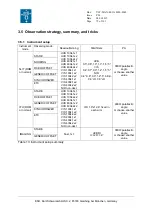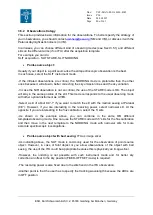
Doc:
Issue
Date
Page
VLT-MAN-ESO-14650-4942
P96
24.06.2015
91 of 161
ESO, Karl-Schwarzschild-Str. 2, 85748 Garching bei München, Germany
ambient temperature increase or if the temperature is high, the Peltier is not cooled down fast
enough and the background/noise structure is higher. However, despite this temporary increase this
detector remains the best acquisition detector at Paranal.
Calibration plan and observing strategies
a) Imaging mode acquisition and exposure times
A basic imaging observing block (OB) consists of a slit or IFU acquisition template, followed
by science and/or calibration imaging templates. However, pure imaging OBs are approved
only in visitor mode. Exceptions in service mode are observations of standard fields for
zeropoint determination or distortion maps. In service mode, OBs can contain imaging
templates in addition to the standard slit or IFU science spectral templates.
There is no ETC support for the imaging mode. We recommend to scale the exposures
times using the limiting magnitudes listed in Table 3. These magnitudes were obtained
under relatively bad weather conditions (thin cirrus, full Moon, seeing about 0.7”).
Table 4bis: Recommended exposure times for the A&G CCD (S/N>5).
V (mag)
6
7
16-20
23
≥24
Exposure time (s) 0.001
0.005
1-5
60-120
≥180
b) Observing strategies
Two science templates are offered:
1.
XSHOOTER_img_obs
: STARE mode observation, i.e., the object stays on the same
detector pixel.
2.
XSHOOTER_img_obs_GenericOffset:
GENERIC-OFFSET mode observations, i.e.,
mapping or jittering around the area of interest.
Table 5bis: Imaging science templates.
Templates
Readout speed
and binning
List of filters
Angles
IMAGING
STARE
GENERIC-
OFFSET
Fast readout,
binning 1x1
U,B,V,R,I,
u’,g’,r’,i’,z’
9999=parallactic angle
or defined angle on
sky
It is recommended to use the
XSHOOTER_img_obs_GenericOffset
template. This template
results in better correction of the sky background and the dust spots visible in the detector.
One can define a sequence of small offsets as shown in the following example. Offsets are
given in arcsec, but the reference system can be chosen to be the sky (Alpha,Delta) or X-
shooter detector coordinate system (X,Y). Offset conventions are illustrated below.
Templates use
cumulative offsets;
the position at a given time is derived from the
sum
of all
offsets specified so far in the template. For example, the series of offsets: 0, -10, 0, 10 brings
the telescope back to the original position for the last exposure.








































